The Spirit of Auvergne

Auvergne used to be considered the geographical centre of France, which has been calculated to lie exactly in the village of Nassigny (Allier). That is true for metropolitan France (including Corsica) but Vesdun (Cher), in the Centre region, claims to be the one for mainland France! However, Auvergne unquestionably is the heartland of the ancient mountain area of the Massif Central. It is a world apart, where it is still possible to feel surrounded by the silence and sweeping panoramas of primordial time, and where one can travel for miles without seeing any sign of civilisation.
A remarkable concentration of dormant volcanoes – first identified in the 18th century and estimated to be between 95,000 and 7,000 years old – shaped the landscape, leaving a strange and majestic terrain, and thermal springs which are famous worldwide. Unique in Europe, Auvergne displays all the volcanic landforms, from huge domes and cones to calderas and maars (crater lakes), lava pyramids and plateaux, faults, cliffs, or solitary spikes of igneous black rock.
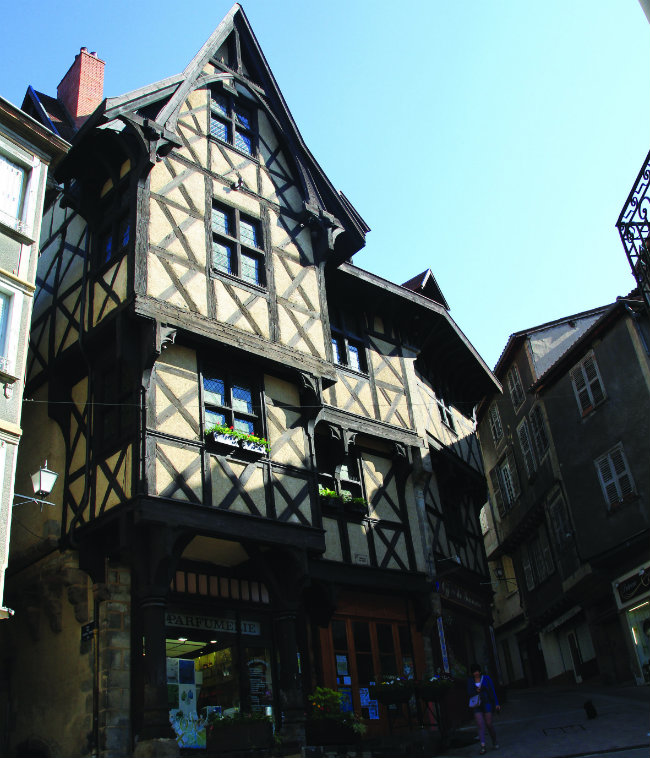
La Maison du Pirou, a historic half-timbered medieval house in Theirs in the Puy-de-Dôme department
Volcanoes are called puys (derived from the Latin podium, a mound), plombs (an alteration of Occitan pom, a rounded summit) or sucs (sugarloaf-shaped mountains or craterless volcanoes). Just south of Clermont-Ferrand, along a north-west to south-west axis, the Chaîne des Puys (Monts Dôme), backed by the Limagne fault and the Chaîne de la Sioule, extends over 40km and numbers 80 volcanoes (Puy de Dôme, 1,465m); the Monts Dore (Massif du Sancy) have the highest peak in Auvergne (Puy de Sancy, 1,886m). The Monts du Cantal range stretches over 240km and features the largest cone shaped stratovolcano in Europe, 60km in diameter (Plomb du Cantal, 1,855m), while the Cézallier basaltic high plateau has an outlandish, mysterious beauty. They are all part of the largest European Nature Park, Le Parc Naturel Regional des Volcans d’Auvergne, created in 1977: 120km long and home to over 90,000 inhabitants, it is an open book on the long and complex historical geology of Auvergne, which generated vastly diverse areas and a distinctive human history.
On the eastern side of the region, in Haute-Loire, lies another basaltic plateau, Devès, along with the Velay and Forez volcanoes. The lava stone quarried for centuries in Volvic (Puy-de-Dôme) and known as Pierre de Volvic, with remarkable qualities and hues ranging from black to grey, gives its singular dark appearance to many Auvergnat buildings.
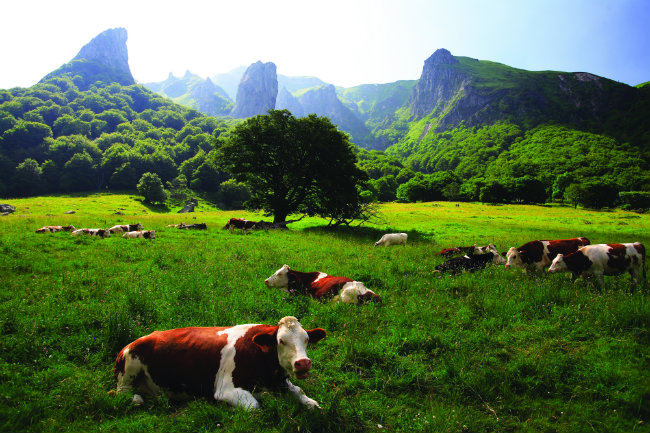
Cows busily ignoring the
fantastical scenery in the
Vallée de Chaudefour
Attitudes Towards the Region
Victim of its largely difficult terrain and harsh climate, consistently depressed economically and under-populated, Auvergne was deliberately bypassed by main roads for a very long time: it was skirted, not penetrated. It was barred from outside influences, and so retained traditions which had been abandoned elsewhere. It is still the kind of place where, in season, wild mushrooms picked only a few hours before are sold in bulk, and by word of mouth, in a local’s barn, between a lathe and drying sausages. It is one of France’s Celtic areas where the famous and vigorous folk dance, bourrée, was born and where people still play the old Auvergnat tunes on bagpipes. They also spoke Occitan dialects until the early 20th century, with the exception of Allier and the northern tip of Puy-de-Dôme.
Paradoxically, the unlocking of Auvergne by the railways in the second half of the 19th century only contributed to the mass exodus of Auvergnat peasants to the capital. A number of them had previously sought a better life in southern French cities and Spain. In Paris, they would originally scratch a living by selling coal and wine – hence their nickname bougnats, a deformation of charbonniers or coal-sellers, pronounced with an Occitan accent – until their hard work and tenacity made them prosperous.
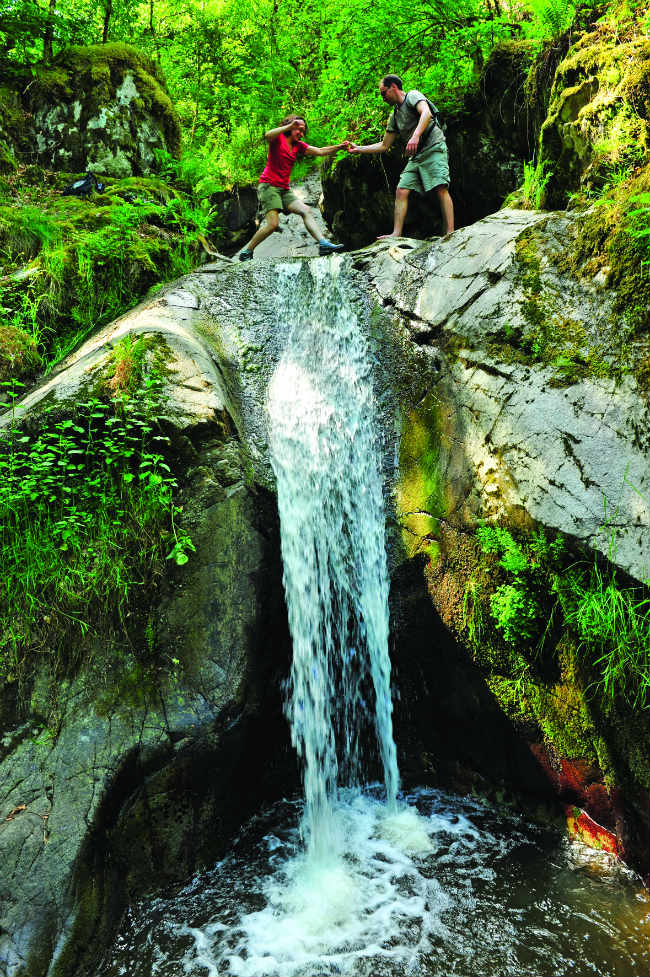
waterfalls in the commune of Combrailles. Photo: Joel Damase
Le Puy-de-Dôme
This is the most densely populated region in Auvergne, partly due to La Limagne, its large and fertile plain of dark volcanic soil – it is the second largest ‘cereal granary’ in France after Beauce (Centre region) – though it is not exempt from light seismic activity. The two pillars of its economy are the global companies Limagrain and Michelin. Limagrain, based in Saint-Beauzire, is the world’s fourth largest company for field, vegetable and tree seeds (Vilmorin brand), the first in Europe for cereal products, and the first in France for industrial baked goods and pastry (Jacquet bread and Brossard biscuits). It is a co-operative group managed by its Auvergnat farming members.
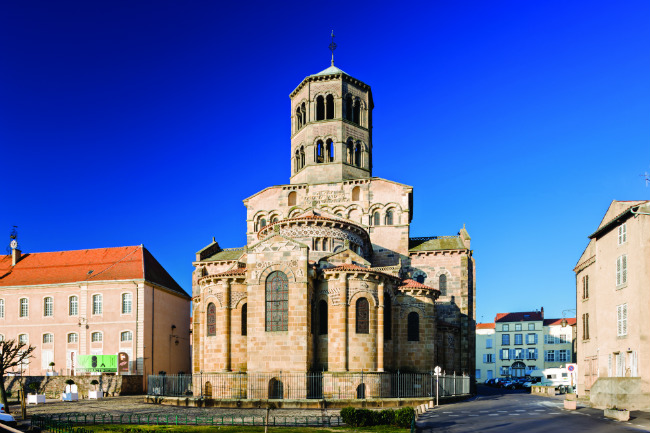
L’Église Saint-Austremoine, one of
five Romanesque churches in Auvergne. Photo: CRDT Auvergne
Clermont-Ferrand, the only large city in Auvergne, is actually made up of two towns, Clairmont and Montferrand, three kilometres apart and joined in the 17th century. Built on a basaltic plateau, it can be seen from far away thanks to the twin black spires of its cathedral. Clermont-Ferrand’s climate is notorious for its extremes in temperature (records of -29°C in winter and 40.7°C in summer) and its dryness, characteristics varying throughout the department because of its contrasted topography. It owes much to the Michelin family, who not only created a world leader in the manufacturing of car tyres, maps and guides, but also took care of its employees’ welfare. The saying goes: ‘Quand Michelin éternue, la ville tousse’ (‘When Michelin sneezes, the city coughs’). There is more than rubber in Clermont, however: a first-class rugby club, the blue-and-yellow ASM Clermont, and the Festival international du Court Métrage (International Short Film Festival), created by the university in 1979, which attracts some 3,000 professionals every year.
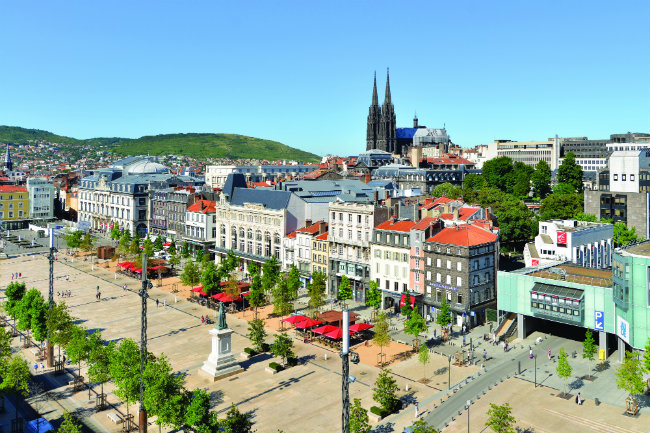
Place de Jaude in
the centre of Clermont-Ferrand. Photo: CRDTA/ Joel Damase
Geographical Features
La Limagne, with its towns of Issoire and Riom, is lower-lying territory and has plenty of sun for its Côtes d’Auvergne vineyards along the Allier river, but the mountains of the Chaîne des Puys (Monts Dôme, Sancy Massif) glower over Clermont-Ferrand: the northern part of the Parc naturel régional des Volcans d’Auvergne starts here. The unspoilt green wall of the Limagne Fault (Faille de Limagne), 3,000m at its deepest, forms both a natural barrier to urban encroachment and a showcase for the Puys.
If the springs of Châtel-Guyon, Le Mont-Dore, Saint-Nectaire, Royat or La Bourboule spas have long-established medicinal qualities, the source at Volvic is familiar to millions of people who drink bottles of this notably pure mineral water, filtered through layers of volcanic rock. Deep, perfectly circular crater lakes (Lacs Chambon, Chauvet, Pavin…) are set like gems amidst tree-clad slopes, while Super Besse is a popular ski resort in Auvergne.
Vulcania, the European park dedicated to vulcanism, and the (very expensive) pet project of Auvergnat President ‘VGE’ (Valéry Giscard d’Estaing), still has to prove its profitability, so lavish were its new educational and recreational programmes.
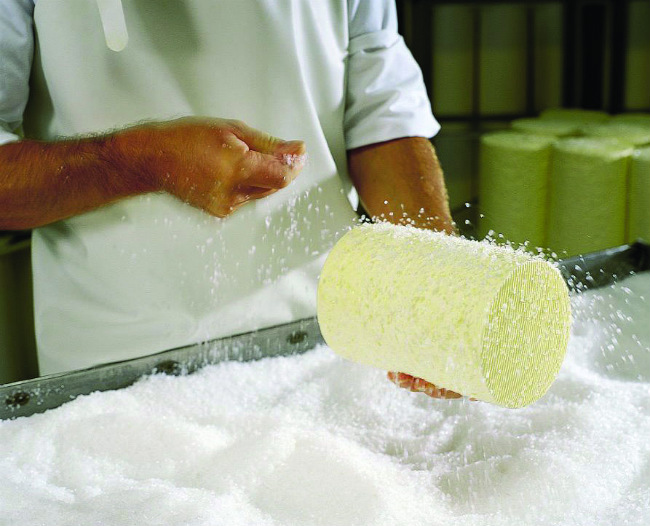
sprinkling salt on
Fourme d’Ambert cheese. Photo: CRDT Auvergne
Le Cantal
Here is one of the most beautiful and sparsely populated departments in France. It’s surrounded by four other Occitan areas: Corrèze, Lot and Aveyron to the west and Lozère to the east. Named after the colossal volcano forming Monts du Cantal – ‘cantal’ is derived from a Celtic word meaning ‘circle’– from which its rivers spring in star fashion, Cantal is Haute-Auvergne, with the highest elevations in the region. Snow is abundant, making Super Lioran the leading Auvergnat ski resort. Cantal shares Le Parc Naturel Régional des Volcans d’Auvergne with Puy-de-Dôme but displays perhaps the most stunning volcanic landscapes: the snow-capped Plomb du Cantal, abrupt Puys (Puy Mary, Puy Violent…), the grassy, windswept solitudes of basaltic plateaux, Cézallier which connects with Puy-de-Dôme Monts Dore or Saint-Flour Planèze; Artense, with its serene highlands and lakes, is the only non-volcanic part.
Beyond the Nature Park, there are the almost lunar expanses of volcanic Aubrac, the dense conifer forests, lakes and spectacular Truyère gorges in the granite wilderness of Margeride, the valleys of Sumène, Cère, Goul, Lot, Célé, Alagnon and Brezons.
It’s hard to decide whether the beauty of Cantal owes more to its nature or to its built heritage. History and Cantalienne culture left a host of Romanesque churches and castles in sumptuous settings: Anjony, Auzers, Laroquebrou, La Vigne or Val in Lanobre, next to the dam of Bort-les-Orgues. Thanks to the solidity of Auvergnat families, villages and towns are remarkably well-preserved, with a hint of mystery, for example medieval Marcolès, Montsalvy, Salers or Tournemire. Salers, the lava-stone architectural gem, is the proud cradle of the eponymous red cattle, whose breed was improved by a local agronomist, Ernest Tyssandier d’Escous (1813-1889), the meaty Salers cheese and the bittersweet Gentiane de Salers aperitif, made from the roots of native Gentiana lutea.
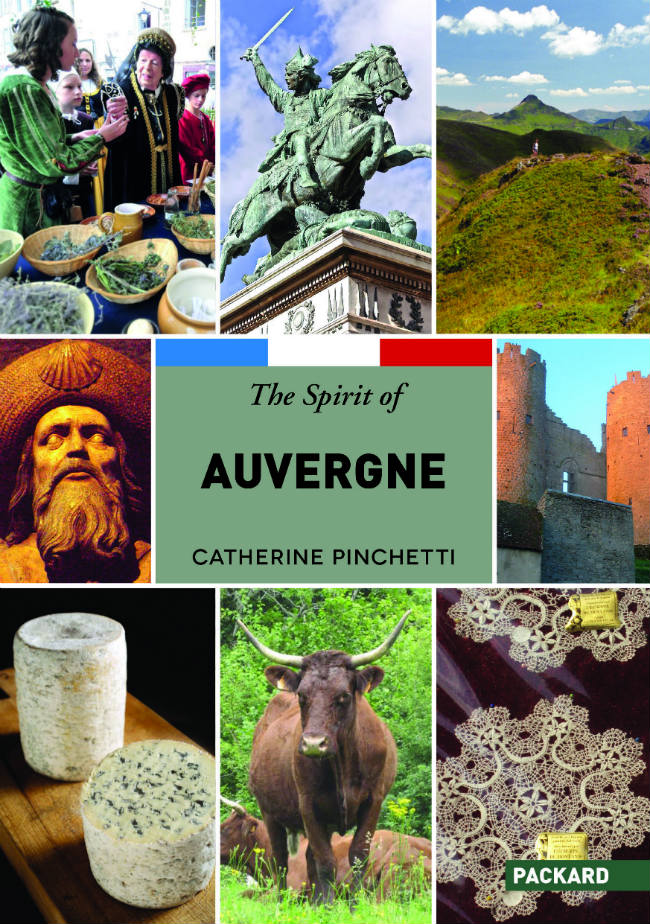
The Spirit of Auvergne by Catherine Pinchetti
Bibendum: the most popular fat ‘man’
The image of a pile of tyres as a grinning fat man was the brainchild of Édouard Michelin, who did not like to see heaps of discarded tyres unused. It was designed in 1898 after the pudgy wooden bonshommes (blokes) displaying menus at restaurant doors of that time. Why a grin? Because the Michelin tyre ‘boit l’obstacle’ (‘devours’ obstacles), and because cars will take you to all kinds of interesting places where you may eat and drink (‘bibendum’ means ‘time to drink’ in Latin). Those were gentler times, but the gastronomic guide Michelin, the other ‘little red book’, first published in 1900 and now covering restaurants in 23 countries, still is the most awaited and dreaded of its kind, removing or bestowing stars of merit as its taste dictates.
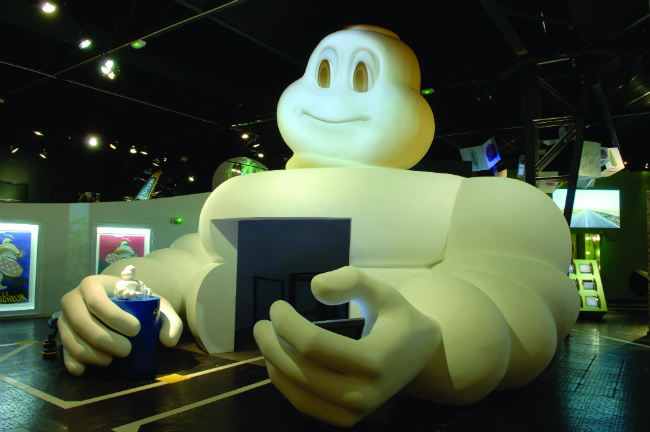
Bibendum
Catherine Pinchetti’s book The Spirit of Auvergne is out now from Packard Publishing.
For more on Auvergne, see www.auvergne-tourism.com.
As seen in France Today magazine
Share to: Facebook Twitter LinkedIn Email
Leave a reply
Your email address will not be published. Required fields are marked *



